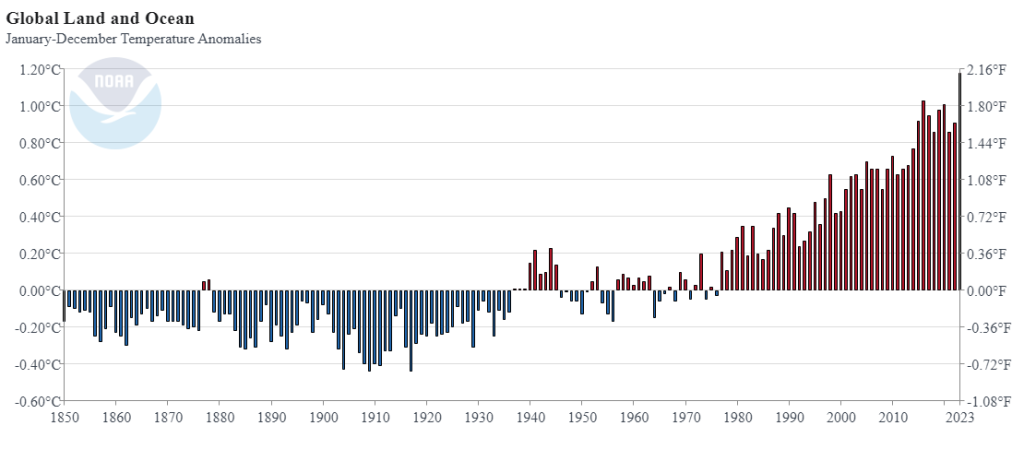Climate Models Did Not Predict This
Gavin Schmidt is a climate modeler at NASA. Climate modeling takes in all of the climate data (climate is an extremely complex and highly interconnected system) from thousands of sensors on the land at different altitudes, and in the oceans at different depths, around the world and uses software to run models of what we can expect the climate to do in the future. 2023 went well beyond and above the temperatures predicted by the models. Temperatures, plus the number of severe weather events, far surpassed the predictions for the year.
A recent NASA/NOAA report named 2023 the hottest year on record.
“The year 2023 was the warmest year since global records began in 1850 at 1.18°C (2.12°F) above the 20th century average of 13.9°C (57.0°F). This value is 0.15°C (0.27°F) more than the previous record set in 2016.”
Is this a trend? Or a temporary anomaly?
The short answer is that Professor Schmidt and his colleagues don’t know… and they find that “very discomfiting”. Why were their predictions off? What must they do to make them more reliable?
Professor Schmidt isn’t confident in the predictive models for 2024. Something is happening beyond the linear (and accelerating) warming trends caused by burning fossil fuels. Something beyond the warming effect of El Nino. Something beyond the minor impact of the solar cycle. (All of which are accounted for in the climate models.)
What input factor have the models not accounted for? The scientists don’t have effective tools to measure the amount of aerosols in the atmosphere. Aerosols are microscopic particles that can reflect sunlight. The more air pollution there is (think smog) the more heat energy is reflected back to space resulting in a cooling of our atmosphere.
So regulations limiting the amount of air pollution are likely contributing to the heating. It’s vital to learn more about how many aerosol particulates we are emitting, and how different types of particulates interact with earth’s atmosphere. There are many health advantages to reducing air pollution. So we want to continue to do that.
NASA is launching a satellite named Plankton, Aerosol, Cloud ocean Ecosystem (PACE) soon that will gather particulate data. That will lay the groundwork for a potentially controversial geoengineering project. Sand is a natural particulate aerosol which gets blown into the atmosphere by desert winds. PACE will help us determine whether sand particles are good at reflecting sunlight. Even if they are, Schmidt warns that if we start releasing large amounts of sand into the atmosphere to cool temperatures, we’d have to continue to do so forever. “How would you calibrate it? Who would govern it? Who pays? It’s a non-starter as far as I’m concerned,” Schmidt said in an interview with Neil deGrasse Tyson.
Schmidt recommends that we focus on reducing our greenhouse gas emissions. “As soon as we stop emitting, the heating will also stop. And over time Nature will disperse the extra gases into space and sequester it in the soil. The composition of our atmosphere and our climate system will gradually return to a pre-industrial state. Our future is determined by our actions. We have agency. We know what to do and we have the tools and technologies today.”
The root issue is who is “we”? We can’t seem to agree on anything in order to address the issues we face. It is critical that we elect leaders (all over the world) who are willing to reject big oil money and champion the transition to a zero carbon circular economy.
Dr. Gavin A. Schmidt is the Director of NASA’s Goddard Institute for Earth Systems Modeling.


